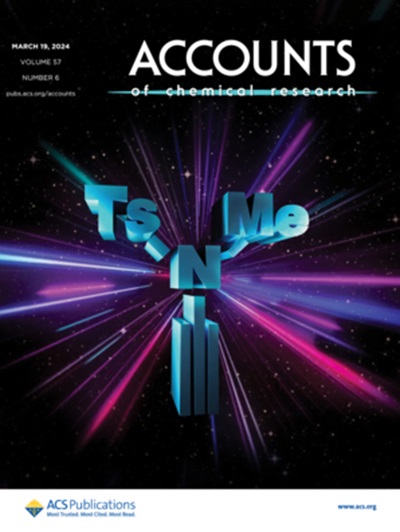What is Editing?
IF 17.7
1区 化学
Q1 CHEMISTRY, MULTIDISCIPLINARY
引用次数: 0
Abstract
Published as part of Accounts of Chemical Research special issue “Skeletal and Stereochemical Editing”. Organic chemistry has an intimate connection with its applications, as synthesis remains the primary tool by which chemical space is navigated in the optimization of functional molecules. Medicinal chemists, for example, will prepare hundreds, if not thousands, of derivatives of promising lead compounds through iterative, parallel synthesis in order to identify the ideal compound to advance to the clinic. In the context of natural products, which have often proven to be valuable starting places for drug discovery, (1,2) the role of synthesis has been central, enabling the preparation of non-natural analogues inaccessible through semisynthesis by diverting from a totally synthetic route. This idea was eloquently captured by Danishefsky, who coined the term “molecular editing” to describe the synthesis of such analogues, essentially advocating for the application of medicinal chemistry principles even in targets as complex as epothilone B. (3) Szpilman and Carreira subsequently wrote an influential review which was responsible for the further proliferation of this coinage, bringing the original term into even broader circulation. (4) Recently, this term-of-art has taken on a very different valence─causing no small amount of confusion─because of a perspective shift in the role of chemical reactions in molecular optimization campaigns. (5−8) Parallel synthesis, though successful, has a fundamental mismatch with the underlying thought process that drives it, as even small changes to a target structure typically require de novo synthesis. This tension has brought on a simple question: can we develop chemical reactions that represent direct analogues to common design strategies? This new movement has also taken on the mantle of “molecular editing”, with distinct forms of optimization-mimicry developing into subfields in their own right: C–H functionalization, functional group interconversion, stereochemical modulation, and skeletal modification have all been encompassed under this redefined heading as flavors of editing, especially when such transformations can be conducted with specificity on complex, late-stage compounds or at nontraditional sites of reactivity. (9−11) A challenge in this vernacular is that, taken at face value, the term molecular editing is synonymous with chemical reaction. It should be clear to even the most cynical reader, however, that not all reactions should be called edits. The above history is instructive here: the reactions that hew closest to the editing ideal are those whose changes are interpretable from a structure–activity relationship perspective. The starting material and product should form a matched molecular pair that a chemist could test to learn something about the landscape of their optimization. (12) The more changes made at once, the further one moves from interpretability. That is, editing is ultimately about simplicity. (13) In this issue of Accounts of Chemical Research, cutting edge research that embodies this movement is surveyed across a wide range of chemical modalities, including transition metal catalysis (including contributions from Ning Jiao, Hao Wei, Xihe Bi, and Guangbin Dong), photochemistry (including contributions from David Sarlah, Frank Glorius, Alison Wendlandt, Ryan Gilmour, and Rob Knowles), and reagent development (including contributions from Hideki Yorimitsu, Manuel Alcarazo, Hongjian Lu, Armido Studer, and Ohyun Kwon). These methods have been applied from small molecules (including site-specific applications highlighted by Scott Miller) to total synthesis (including contributions from Mingji Dai and Richmond Sarpong) and polymers (including a contribution from Aleksandr Zhukovitskiy). Together, these approaches enable useful and often surprising transformations. We thank the authors of each of the contributions that are presented herein, which highlight many of the emerging thought processes that continue to shape this exciting and evolving direction for chemical synthesis research. We are also grateful to Associate Editor Prof. Abigail Doyle, Editor-in-Chief Prof. Christopher Chang, and the rest of the editorial team at Accounts of Chemical Research for proposing this timely special issue. This collection of exciting contributions makes clear that not only can reactions be devised that begin to mimic the creative process of navigating chemical space but that we are also at an inflection point for such methods; as this toolbox grows, the discovery campaigns of tomorrow will be empowered to reduce their vision to practice, one molecular edit at a time. This article references 13 other publications. This article has not yet been cited by other publications.什么是编辑?
作为化学研究专刊“骨骼和立体化学编辑”的一部分发表。有机化学与其应用有着密切的联系,因为合成仍然是在功能分子优化中导航化学空间的主要工具。例如,药物化学家将通过迭代、平行合成来制备数百种(如果不是数千种的话)有前途的先导化合物的衍生物,以确定用于临床的理想化合物。天然产物通常被证明是药物发现的有价值的起点,(1,2)合成的作用一直是中心的,使非天然类似物的制备能够通过半合成而无法通过完全合成的途径获得。丹尼舍夫斯基雄辩地抓住了这一观点,他创造了“分子编辑”一词来描述这种类似物的合成,本质上是提倡将药物化学原理应用于像埃波霉素b这样复杂的目标。(3)斯比尔曼和卡雷拉随后写了一篇有影响力的评论,这篇评论导致了这个新词的进一步扩散,使最初的术语进入了更广泛的流通。(4)最近,由于化学反应在分子优化活动中的作用的观点发生了转变,这一艺术术语呈现出了非常不同的价值──引起了不小的困惑。(5−8)并行合成虽然成功,但与驱动它的潜在思维过程存在根本的不匹配,因为即使是对目标结构的微小变化通常也需要从头合成。这种紧张关系带来了一个简单的问题:我们能否开发出一种化学反应,直接类似于常见的设计策略?这一新的运动也承担了“分子编辑”的斗篷,不同形式的优化模仿发展成自己的子领域:碳氢官能化,官能团相互转换,立体化学调制和骨架修饰都包含在这个重新定义的标题下,作为编辑的味道,特别是当这些转化可以在复杂的,晚期化合物或非传统反应性位点上进行特异性时。(9−11)这个术语的一个挑战是,从表面上看,术语分子编辑是化学反应的同义词。然而,即使是最愤世嫉俗的读者也应该清楚,并非所有的反应都应该被称为编辑。上面的历史在这里很有启发性:最接近编辑理想的反应是那些从结构-活动关系的角度可以解释的变化。起始材料和产物应该形成匹配的分子对,化学家可以通过测试来了解它们的优化过程。(12)一次做的改动越多,离可解释性就越远。也就是说,编辑的最终目的是简单。(13)本期《化学研究报告》对体现这一运动的前沿研究进行了广泛的化学模式调查,包括过渡金属催化(包括焦宁、魏浩、毕希和和董广彬的贡献)、光化学(包括David Sarlah、Frank Glorius、Alison Wendlandt、Ryan Gilmour和Rob Knowles的贡献)和试剂开发(包括Hideki Yorimitsu、Manuel Alcarazo、卢宏建,阿米多·斯图德,权五铉)。这些方法已经从小分子(包括Scott Miller强调的特定位点应用)到全合成(包括Mingji Dai和Richmond Sarpong的贡献)和聚合物(包括Aleksandr Zhukovitskiy的贡献)。总之,这些方法可以实现有用且经常令人惊讶的转换。我们感谢在此提出的每个贡献的作者,这些贡献突出了许多新兴的思维过程,这些思维过程继续塑造化学合成研究这一令人兴奋和不断发展的方向。我们也感谢《化学研究账户》的副主编Abigail Doyle教授、总编辑Christopher Chang教授和其他编辑团队及时提出这个特刊。这些令人兴奋的贡献清楚地表明,不仅可以设计出模仿化学空间导航的创造性过程的反应,而且我们也处于此类方法的拐点;随着这个工具箱的发展,未来的发现运动将被授权将他们的愿景变为实践,一次一个分子的编辑。本文引用了其他13个出版物。这篇文章尚未被其他出版物引用。
本文章由计算机程序翻译,如有差异,请以英文原文为准。
求助全文
约1分钟内获得全文
求助全文
来源期刊

Accounts of Chemical Research
化学-化学综合
CiteScore
31.40
自引率
1.10%
发文量
312
审稿时长
2 months
期刊介绍:
Accounts of Chemical Research presents short, concise and critical articles offering easy-to-read overviews of basic research and applications in all areas of chemistry and biochemistry. These short reviews focus on research from the author’s own laboratory and are designed to teach the reader about a research project. In addition, Accounts of Chemical Research publishes commentaries that give an informed opinion on a current research problem. Special Issues online are devoted to a single topic of unusual activity and significance.
Accounts of Chemical Research replaces the traditional article abstract with an article "Conspectus." These entries synopsize the research affording the reader a closer look at the content and significance of an article. Through this provision of a more detailed description of the article contents, the Conspectus enhances the article's discoverability by search engines and the exposure for the research.
 求助内容:
求助内容: 应助结果提醒方式:
应助结果提醒方式:


